Water Sensitive Urban Design: Storm Water Quality Improvement Report
VerifiedAdded on 2023/06/09
|28
|7039
|180
Report
AI Summary
This report delves into Water Sensitive Urban Design (WSUD), a crucial approach to urban planning aimed at minimizing storm water damage and maximizing water use efficiency. It explores how traditional urban development alters natural water flow, leading to increased runoff and pollution. The report outlines the principles, objectives, and various techniques of WSUD, including bio-retention systems, infiltration systems, and porous paving. It also examines the benefits of WSUD, such as improved storm water quality, flood control, and enhanced urban environments. Furthermore, the report provides background information, policy, planning, and legislation related to WSUD, emphasizing its role in integrated urban water management and sustainable urban drainage systems. It highlights the importance of addressing knowledge gaps to facilitate the broader implementation of WSUD, ultimately contributing to more sustainable and resilient urban areas.
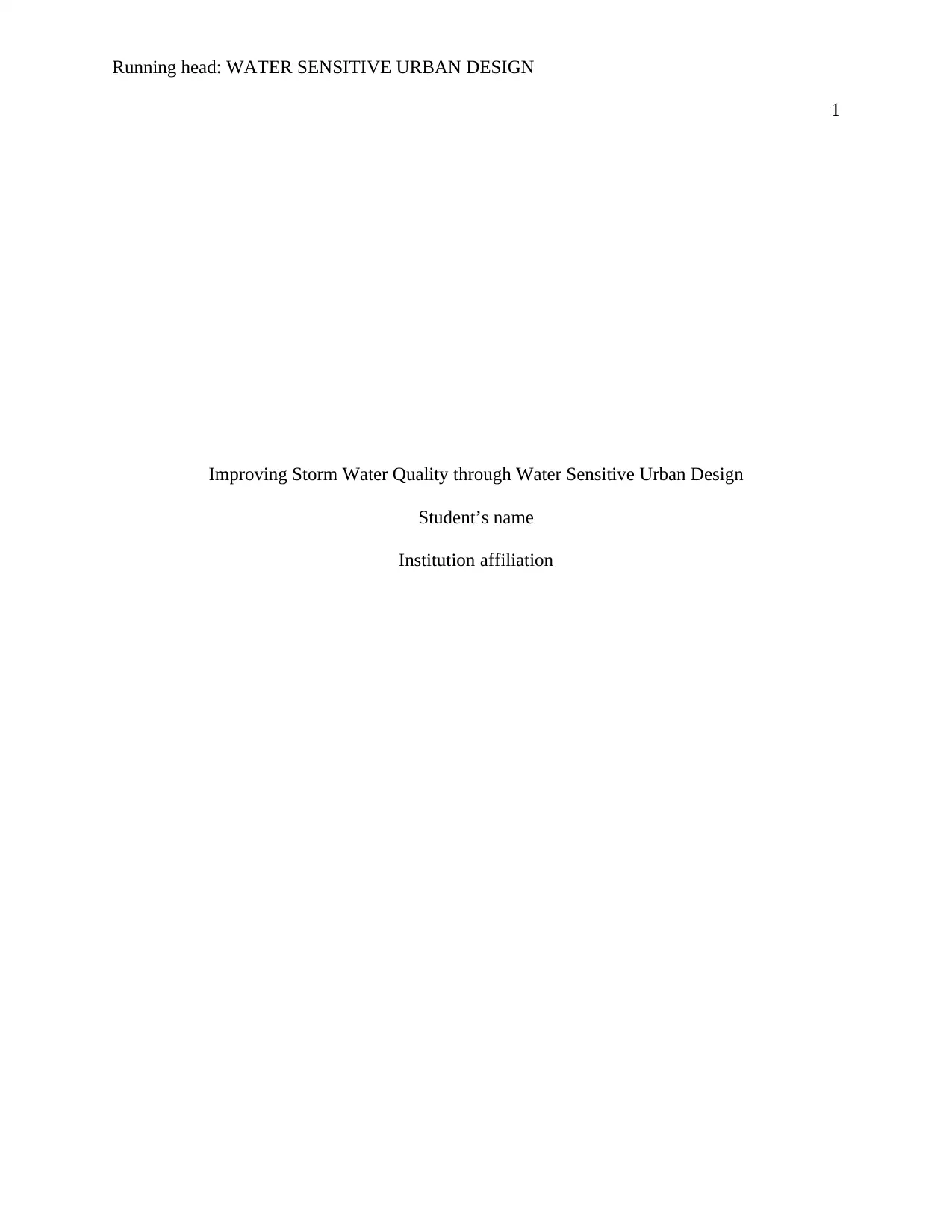
Running head: WATER SENSITIVE URBAN DESIGN
1
Improving Storm Water Quality through Water Sensitive Urban Design
Student’s name
Institution affiliation
1
Improving Storm Water Quality through Water Sensitive Urban Design
Student’s name
Institution affiliation
Paraphrase This Document
Need a fresh take? Get an instant paraphrase of this document with our AI Paraphraser
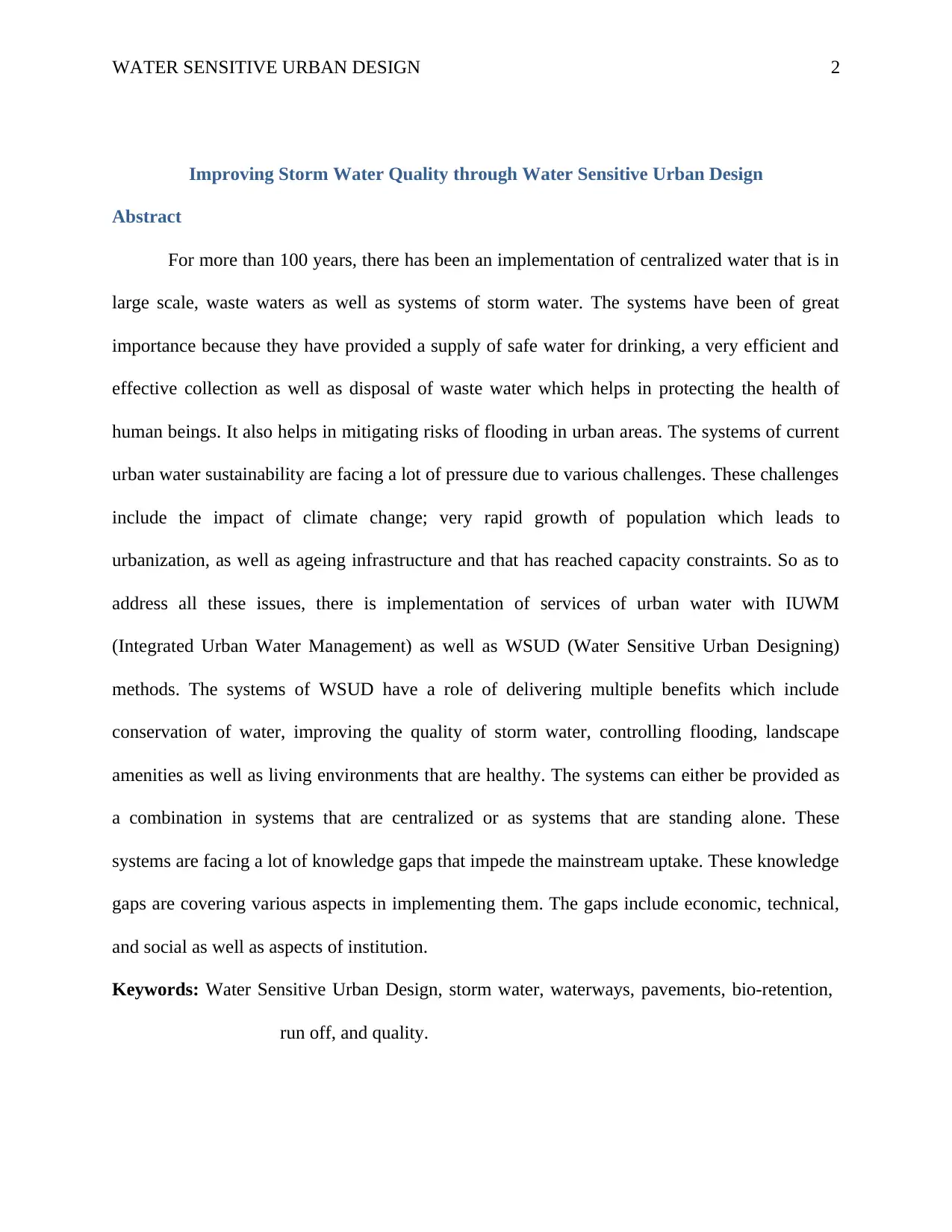
WATER SENSITIVE URBAN DESIGN 2
Improving Storm Water Quality through Water Sensitive Urban Design
Abstract
For more than 100 years, there has been an implementation of centralized water that is in
large scale, waste waters as well as systems of storm water. The systems have been of great
importance because they have provided a supply of safe water for drinking, a very efficient and
effective collection as well as disposal of waste water which helps in protecting the health of
human beings. It also helps in mitigating risks of flooding in urban areas. The systems of current
urban water sustainability are facing a lot of pressure due to various challenges. These challenges
include the impact of climate change; very rapid growth of population which leads to
urbanization, as well as ageing infrastructure and that has reached capacity constraints. So as to
address all these issues, there is implementation of services of urban water with IUWM
(Integrated Urban Water Management) as well as WSUD (Water Sensitive Urban Designing)
methods. The systems of WSUD have a role of delivering multiple benefits which include
conservation of water, improving the quality of storm water, controlling flooding, landscape
amenities as well as living environments that are healthy. The systems can either be provided as
a combination in systems that are centralized or as systems that are standing alone. These
systems are facing a lot of knowledge gaps that impede the mainstream uptake. These knowledge
gaps are covering various aspects in implementing them. The gaps include economic, technical,
and social as well as aspects of institution.
Keywords: Water Sensitive Urban Design, storm water, waterways, pavements, bio-retention,
run off, and quality.
Improving Storm Water Quality through Water Sensitive Urban Design
Abstract
For more than 100 years, there has been an implementation of centralized water that is in
large scale, waste waters as well as systems of storm water. The systems have been of great
importance because they have provided a supply of safe water for drinking, a very efficient and
effective collection as well as disposal of waste water which helps in protecting the health of
human beings. It also helps in mitigating risks of flooding in urban areas. The systems of current
urban water sustainability are facing a lot of pressure due to various challenges. These challenges
include the impact of climate change; very rapid growth of population which leads to
urbanization, as well as ageing infrastructure and that has reached capacity constraints. So as to
address all these issues, there is implementation of services of urban water with IUWM
(Integrated Urban Water Management) as well as WSUD (Water Sensitive Urban Designing)
methods. The systems of WSUD have a role of delivering multiple benefits which include
conservation of water, improving the quality of storm water, controlling flooding, landscape
amenities as well as living environments that are healthy. The systems can either be provided as
a combination in systems that are centralized or as systems that are standing alone. These
systems are facing a lot of knowledge gaps that impede the mainstream uptake. These knowledge
gaps are covering various aspects in implementing them. The gaps include economic, technical,
and social as well as aspects of institution.
Keywords: Water Sensitive Urban Design, storm water, waterways, pavements, bio-retention,
run off, and quality.
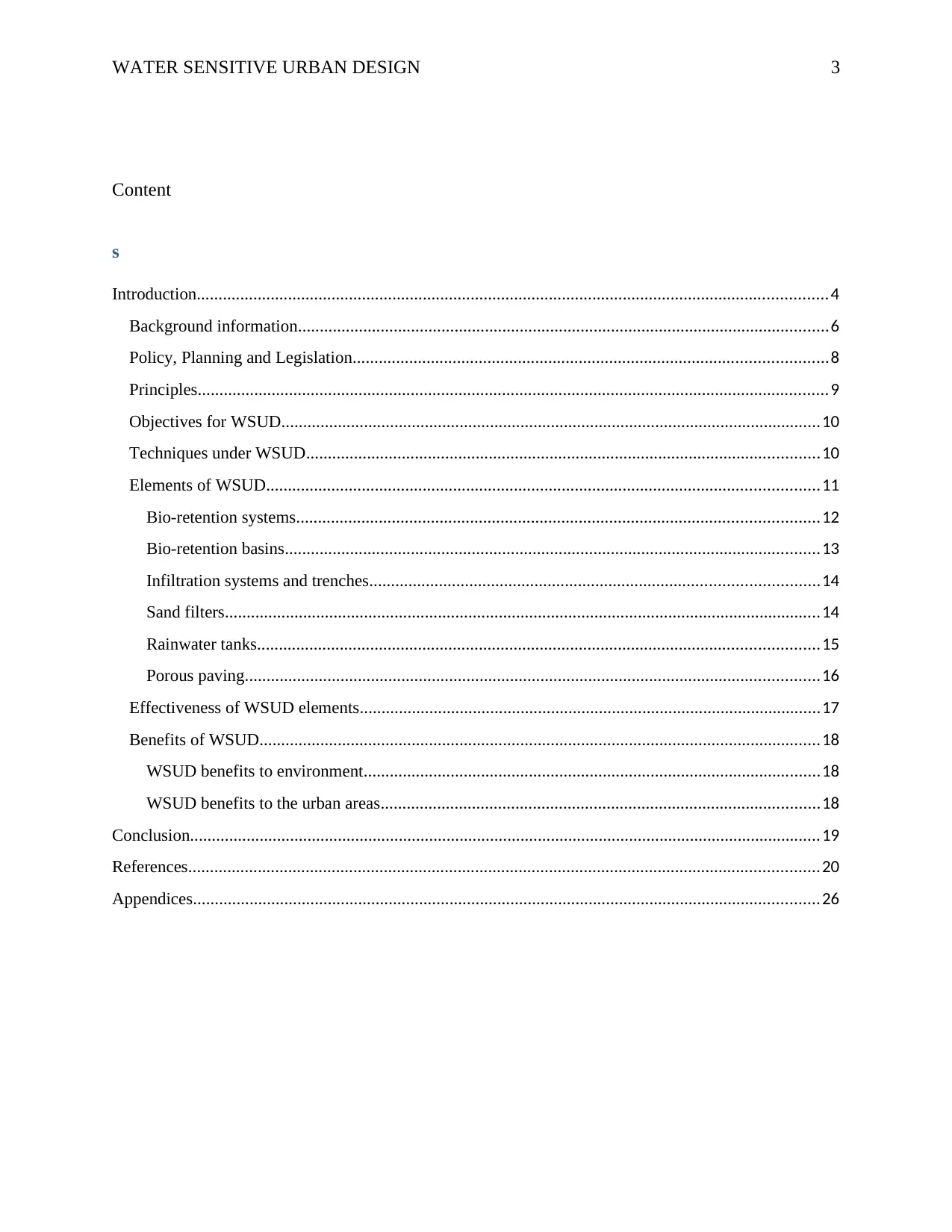
WATER SENSITIVE URBAN DESIGN 3
Content
s
Introduction.................................................................................................................................................4
Background information..........................................................................................................................6
Policy, Planning and Legislation.............................................................................................................8
Principles.................................................................................................................................................9
Objectives for WSUD............................................................................................................................10
Techniques under WSUD......................................................................................................................10
Elements of WSUD...............................................................................................................................11
Bio-retention systems........................................................................................................................12
Bio-retention basins...........................................................................................................................13
Infiltration systems and trenches.......................................................................................................14
Sand filters.........................................................................................................................................14
Rainwater tanks.................................................................................................................................15
Porous paving....................................................................................................................................16
Effectiveness of WSUD elements..........................................................................................................17
Benefits of WSUD.................................................................................................................................18
WSUD benefits to environment.........................................................................................................18
WSUD benefits to the urban areas.....................................................................................................18
Conclusion.................................................................................................................................................19
References.................................................................................................................................................20
Appendices................................................................................................................................................26
Content
s
Introduction.................................................................................................................................................4
Background information..........................................................................................................................6
Policy, Planning and Legislation.............................................................................................................8
Principles.................................................................................................................................................9
Objectives for WSUD............................................................................................................................10
Techniques under WSUD......................................................................................................................10
Elements of WSUD...............................................................................................................................11
Bio-retention systems........................................................................................................................12
Bio-retention basins...........................................................................................................................13
Infiltration systems and trenches.......................................................................................................14
Sand filters.........................................................................................................................................14
Rainwater tanks.................................................................................................................................15
Porous paving....................................................................................................................................16
Effectiveness of WSUD elements..........................................................................................................17
Benefits of WSUD.................................................................................................................................18
WSUD benefits to environment.........................................................................................................18
WSUD benefits to the urban areas.....................................................................................................18
Conclusion.................................................................................................................................................19
References.................................................................................................................................................20
Appendices................................................................................................................................................26
⊘ This is a preview!⊘
Do you want full access?
Subscribe today to unlock all pages.

Trusted by 1+ million students worldwide
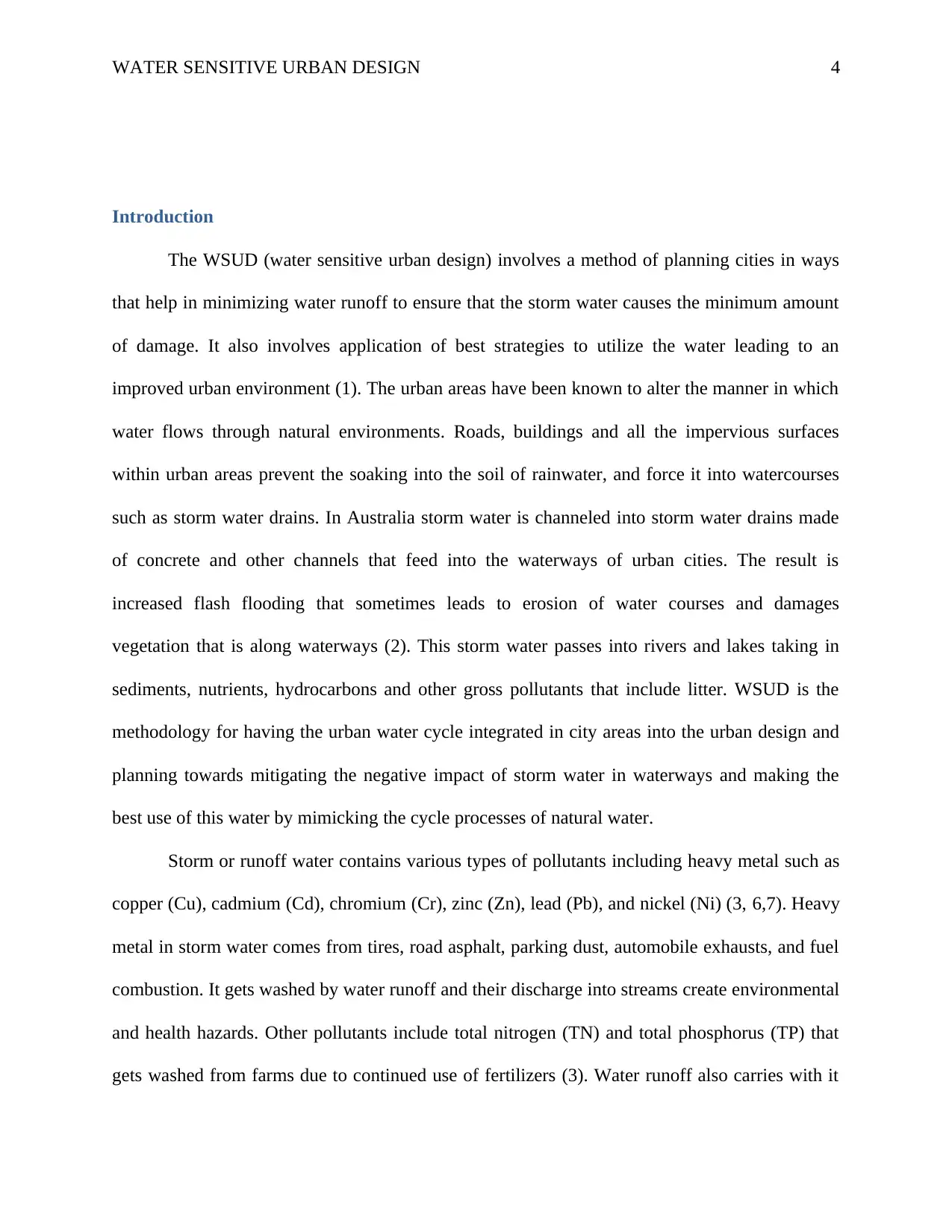
WATER SENSITIVE URBAN DESIGN 4
Introduction
The WSUD (water sensitive urban design) involves a method of planning cities in ways
that help in minimizing water runoff to ensure that the storm water causes the minimum amount
of damage. It also involves application of best strategies to utilize the water leading to an
improved urban environment (1). The urban areas have been known to alter the manner in which
water flows through natural environments. Roads, buildings and all the impervious surfaces
within urban areas prevent the soaking into the soil of rainwater, and force it into watercourses
such as storm water drains. In Australia storm water is channeled into storm water drains made
of concrete and other channels that feed into the waterways of urban cities. The result is
increased flash flooding that sometimes leads to erosion of water courses and damages
vegetation that is along waterways (2). This storm water passes into rivers and lakes taking in
sediments, nutrients, hydrocarbons and other gross pollutants that include litter. WSUD is the
methodology for having the urban water cycle integrated in city areas into the urban design and
planning towards mitigating the negative impact of storm water in waterways and making the
best use of this water by mimicking the cycle processes of natural water.
Storm or runoff water contains various types of pollutants including heavy metal such as
copper (Cu), cadmium (Cd), chromium (Cr), zinc (Zn), lead (Pb), and nickel (Ni) (3, 6,7). Heavy
metal in storm water comes from tires, road asphalt, parking dust, automobile exhausts, and fuel
combustion. It gets washed by water runoff and their discharge into streams create environmental
and health hazards. Other pollutants include total nitrogen (TN) and total phosphorus (TP) that
gets washed from farms due to continued use of fertilizers (3). Water runoff also carries with it
Introduction
The WSUD (water sensitive urban design) involves a method of planning cities in ways
that help in minimizing water runoff to ensure that the storm water causes the minimum amount
of damage. It also involves application of best strategies to utilize the water leading to an
improved urban environment (1). The urban areas have been known to alter the manner in which
water flows through natural environments. Roads, buildings and all the impervious surfaces
within urban areas prevent the soaking into the soil of rainwater, and force it into watercourses
such as storm water drains. In Australia storm water is channeled into storm water drains made
of concrete and other channels that feed into the waterways of urban cities. The result is
increased flash flooding that sometimes leads to erosion of water courses and damages
vegetation that is along waterways (2). This storm water passes into rivers and lakes taking in
sediments, nutrients, hydrocarbons and other gross pollutants that include litter. WSUD is the
methodology for having the urban water cycle integrated in city areas into the urban design and
planning towards mitigating the negative impact of storm water in waterways and making the
best use of this water by mimicking the cycle processes of natural water.
Storm or runoff water contains various types of pollutants including heavy metal such as
copper (Cu), cadmium (Cd), chromium (Cr), zinc (Zn), lead (Pb), and nickel (Ni) (3, 6,7). Heavy
metal in storm water comes from tires, road asphalt, parking dust, automobile exhausts, and fuel
combustion. It gets washed by water runoff and their discharge into streams create environmental
and health hazards. Other pollutants include total nitrogen (TN) and total phosphorus (TP) that
gets washed from farms due to continued use of fertilizers (3). Water runoff also carries with it
Paraphrase This Document
Need a fresh take? Get an instant paraphrase of this document with our AI Paraphraser
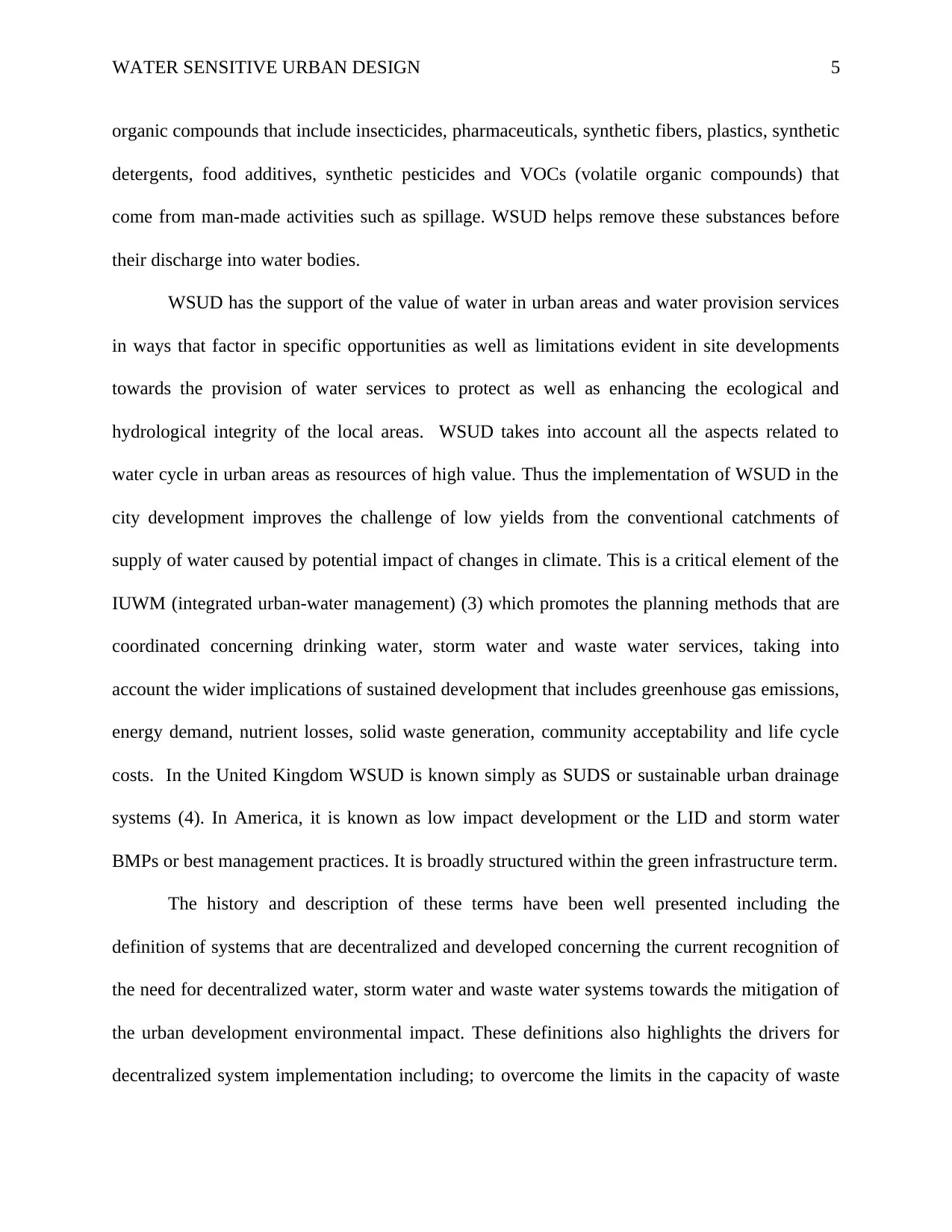
WATER SENSITIVE URBAN DESIGN 5
organic compounds that include insecticides, pharmaceuticals, synthetic fibers, plastics, synthetic
detergents, food additives, synthetic pesticides and VOCs (volatile organic compounds) that
come from man-made activities such as spillage. WSUD helps remove these substances before
their discharge into water bodies.
WSUD has the support of the value of water in urban areas and water provision services
in ways that factor in specific opportunities as well as limitations evident in site developments
towards the provision of water services to protect as well as enhancing the ecological and
hydrological integrity of the local areas. WSUD takes into account all the aspects related to
water cycle in urban areas as resources of high value. Thus the implementation of WSUD in the
city development improves the challenge of low yields from the conventional catchments of
supply of water caused by potential impact of changes in climate. This is a critical element of the
IUWM (integrated urban-water management) (3) which promotes the planning methods that are
coordinated concerning drinking water, storm water and waste water services, taking into
account the wider implications of sustained development that includes greenhouse gas emissions,
energy demand, nutrient losses, solid waste generation, community acceptability and life cycle
costs. In the United Kingdom WSUD is known simply as SUDS or sustainable urban drainage
systems (4). In America, it is known as low impact development or the LID and storm water
BMPs or best management practices. It is broadly structured within the green infrastructure term.
The history and description of these terms have been well presented including the
definition of systems that are decentralized and developed concerning the current recognition of
the need for decentralized water, storm water and waste water systems towards the mitigation of
the urban development environmental impact. These definitions also highlights the drivers for
decentralized system implementation including; to overcome the limits in the capacity of waste
organic compounds that include insecticides, pharmaceuticals, synthetic fibers, plastics, synthetic
detergents, food additives, synthetic pesticides and VOCs (volatile organic compounds) that
come from man-made activities such as spillage. WSUD helps remove these substances before
their discharge into water bodies.
WSUD has the support of the value of water in urban areas and water provision services
in ways that factor in specific opportunities as well as limitations evident in site developments
towards the provision of water services to protect as well as enhancing the ecological and
hydrological integrity of the local areas. WSUD takes into account all the aspects related to
water cycle in urban areas as resources of high value. Thus the implementation of WSUD in the
city development improves the challenge of low yields from the conventional catchments of
supply of water caused by potential impact of changes in climate. This is a critical element of the
IUWM (integrated urban-water management) (3) which promotes the planning methods that are
coordinated concerning drinking water, storm water and waste water services, taking into
account the wider implications of sustained development that includes greenhouse gas emissions,
energy demand, nutrient losses, solid waste generation, community acceptability and life cycle
costs. In the United Kingdom WSUD is known simply as SUDS or sustainable urban drainage
systems (4). In America, it is known as low impact development or the LID and storm water
BMPs or best management practices. It is broadly structured within the green infrastructure term.
The history and description of these terms have been well presented including the
definition of systems that are decentralized and developed concerning the current recognition of
the need for decentralized water, storm water and waste water systems towards the mitigation of
the urban development environmental impact. These definitions also highlights the drivers for
decentralized system implementation including; to overcome the limits in the capacity of waste
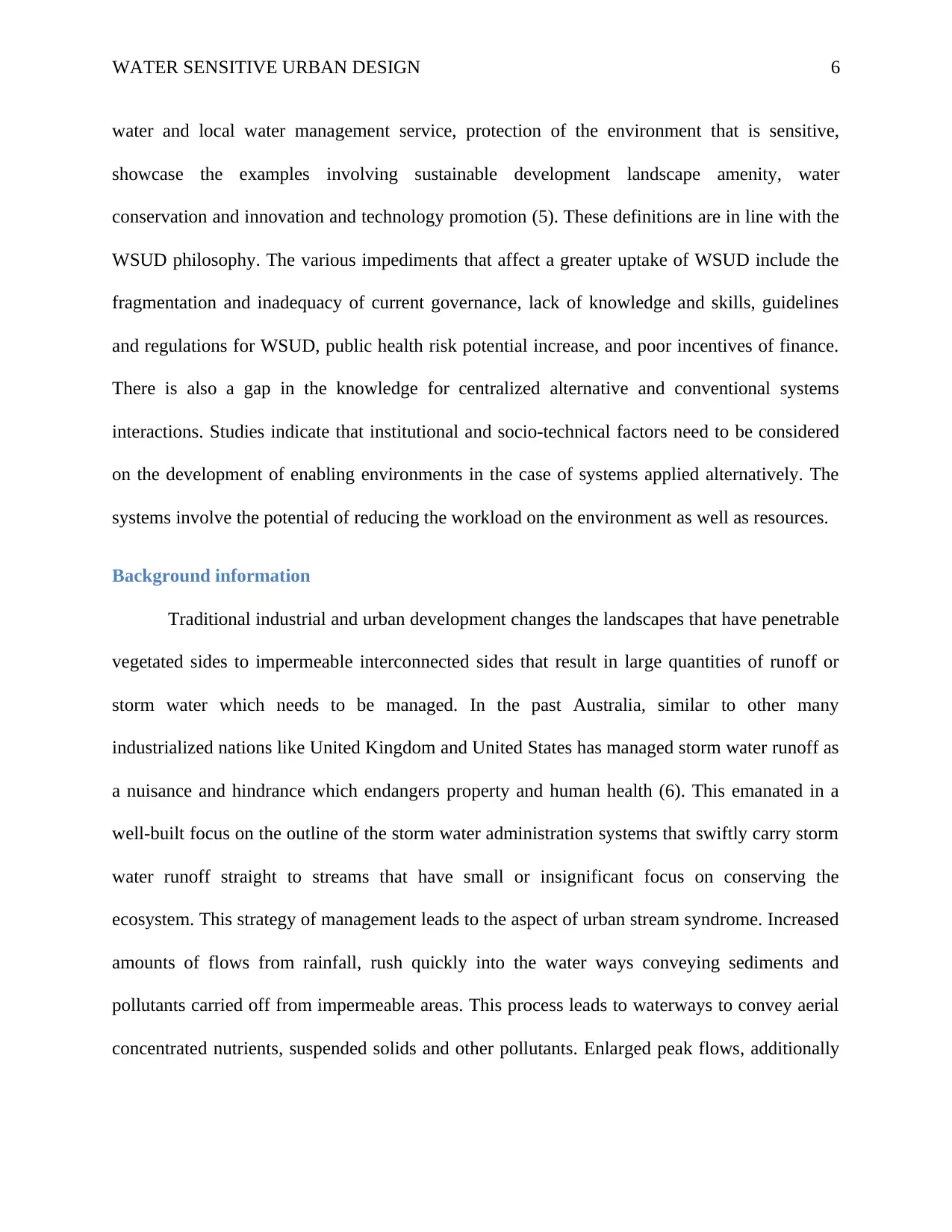
WATER SENSITIVE URBAN DESIGN 6
water and local water management service, protection of the environment that is sensitive,
showcase the examples involving sustainable development landscape amenity, water
conservation and innovation and technology promotion (5). These definitions are in line with the
WSUD philosophy. The various impediments that affect a greater uptake of WSUD include the
fragmentation and inadequacy of current governance, lack of knowledge and skills, guidelines
and regulations for WSUD, public health risk potential increase, and poor incentives of finance.
There is also a gap in the knowledge for centralized alternative and conventional systems
interactions. Studies indicate that institutional and socio-technical factors need to be considered
on the development of enabling environments in the case of systems applied alternatively. The
systems involve the potential of reducing the workload on the environment as well as resources.
Background information
Traditional industrial and urban development changes the landscapes that have penetrable
vegetated sides to impermeable interconnected sides that result in large quantities of runoff or
storm water which needs to be managed. In the past Australia, similar to other many
industrialized nations like United Kingdom and United States has managed storm water runoff as
a nuisance and hindrance which endangers property and human health (6). This emanated in a
well-built focus on the outline of the storm water administration systems that swiftly carry storm
water runoff straight to streams that have small or insignificant focus on conserving the
ecosystem. This strategy of management leads to the aspect of urban stream syndrome. Increased
amounts of flows from rainfall, rush quickly into the water ways conveying sediments and
pollutants carried off from impermeable areas. This process leads to waterways to convey aerial
concentrated nutrients, suspended solids and other pollutants. Enlarged peak flows, additionally
water and local water management service, protection of the environment that is sensitive,
showcase the examples involving sustainable development landscape amenity, water
conservation and innovation and technology promotion (5). These definitions are in line with the
WSUD philosophy. The various impediments that affect a greater uptake of WSUD include the
fragmentation and inadequacy of current governance, lack of knowledge and skills, guidelines
and regulations for WSUD, public health risk potential increase, and poor incentives of finance.
There is also a gap in the knowledge for centralized alternative and conventional systems
interactions. Studies indicate that institutional and socio-technical factors need to be considered
on the development of enabling environments in the case of systems applied alternatively. The
systems involve the potential of reducing the workload on the environment as well as resources.
Background information
Traditional industrial and urban development changes the landscapes that have penetrable
vegetated sides to impermeable interconnected sides that result in large quantities of runoff or
storm water which needs to be managed. In the past Australia, similar to other many
industrialized nations like United Kingdom and United States has managed storm water runoff as
a nuisance and hindrance which endangers property and human health (6). This emanated in a
well-built focus on the outline of the storm water administration systems that swiftly carry storm
water runoff straight to streams that have small or insignificant focus on conserving the
ecosystem. This strategy of management leads to the aspect of urban stream syndrome. Increased
amounts of flows from rainfall, rush quickly into the water ways conveying sediments and
pollutants carried off from impermeable areas. This process leads to waterways to convey aerial
concentrated nutrients, suspended solids and other pollutants. Enlarged peak flows, additionally
⊘ This is a preview!⊘
Do you want full access?
Subscribe today to unlock all pages.

Trusted by 1+ million students worldwide
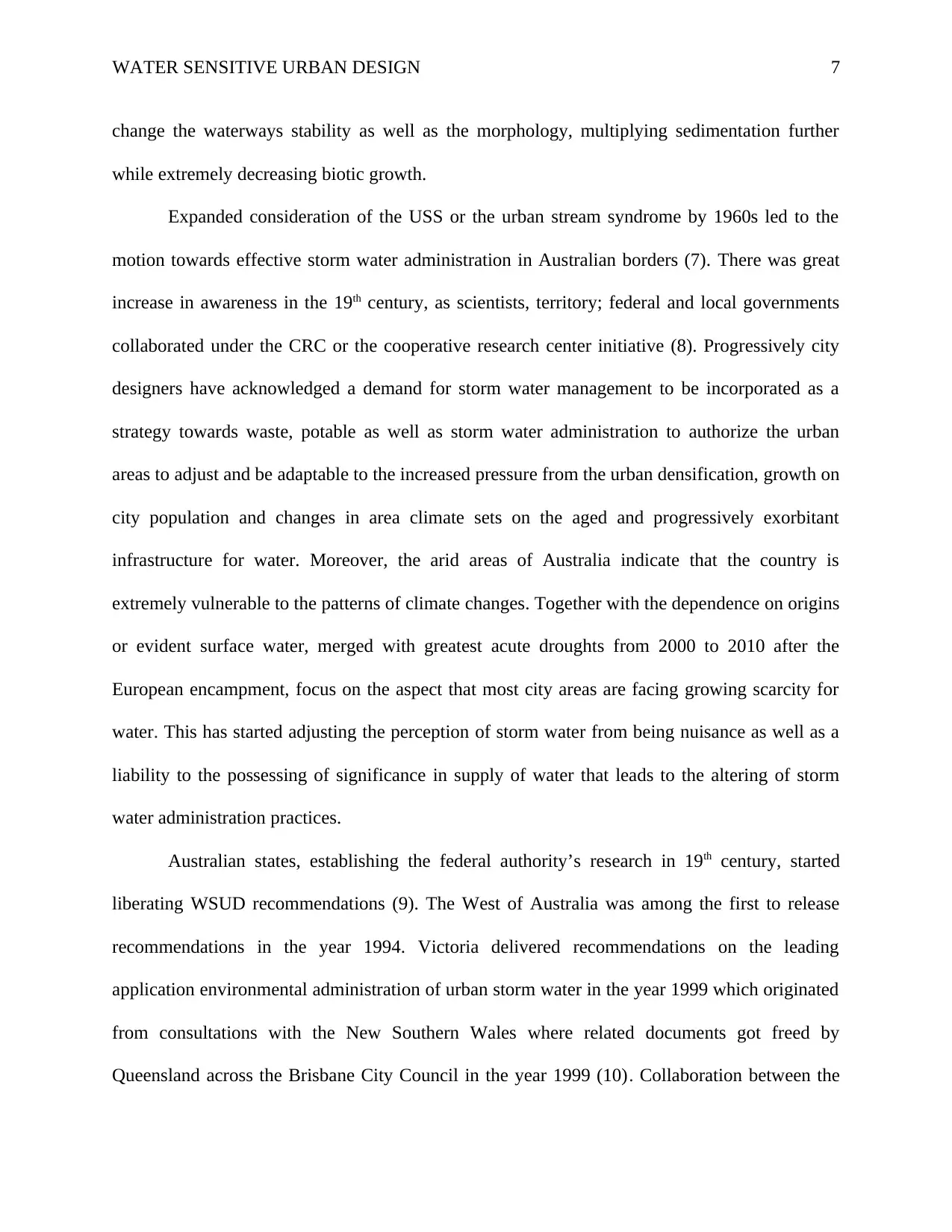
WATER SENSITIVE URBAN DESIGN 7
change the waterways stability as well as the morphology, multiplying sedimentation further
while extremely decreasing biotic growth.
Expanded consideration of the USS or the urban stream syndrome by 1960s led to the
motion towards effective storm water administration in Australian borders (7). There was great
increase in awareness in the 19th century, as scientists, territory; federal and local governments
collaborated under the CRC or the cooperative research center initiative (8). Progressively city
designers have acknowledged a demand for storm water management to be incorporated as a
strategy towards waste, potable as well as storm water administration to authorize the urban
areas to adjust and be adaptable to the increased pressure from the urban densification, growth on
city population and changes in area climate sets on the aged and progressively exorbitant
infrastructure for water. Moreover, the arid areas of Australia indicate that the country is
extremely vulnerable to the patterns of climate changes. Together with the dependence on origins
or evident surface water, merged with greatest acute droughts from 2000 to 2010 after the
European encampment, focus on the aspect that most city areas are facing growing scarcity for
water. This has started adjusting the perception of storm water from being nuisance as well as a
liability to the possessing of significance in supply of water that leads to the altering of storm
water administration practices.
Australian states, establishing the federal authority’s research in 19th century, started
liberating WSUD recommendations (9). The West of Australia was among the first to release
recommendations in the year 1994. Victoria delivered recommendations on the leading
application environmental administration of urban storm water in the year 1999 which originated
from consultations with the New Southern Wales where related documents got freed by
Queensland across the Brisbane City Council in the year 1999 (10). Collaboration between the
change the waterways stability as well as the morphology, multiplying sedimentation further
while extremely decreasing biotic growth.
Expanded consideration of the USS or the urban stream syndrome by 1960s led to the
motion towards effective storm water administration in Australian borders (7). There was great
increase in awareness in the 19th century, as scientists, territory; federal and local governments
collaborated under the CRC or the cooperative research center initiative (8). Progressively city
designers have acknowledged a demand for storm water management to be incorporated as a
strategy towards waste, potable as well as storm water administration to authorize the urban
areas to adjust and be adaptable to the increased pressure from the urban densification, growth on
city population and changes in area climate sets on the aged and progressively exorbitant
infrastructure for water. Moreover, the arid areas of Australia indicate that the country is
extremely vulnerable to the patterns of climate changes. Together with the dependence on origins
or evident surface water, merged with greatest acute droughts from 2000 to 2010 after the
European encampment, focus on the aspect that most city areas are facing growing scarcity for
water. This has started adjusting the perception of storm water from being nuisance as well as a
liability to the possessing of significance in supply of water that leads to the altering of storm
water administration practices.
Australian states, establishing the federal authority’s research in 19th century, started
liberating WSUD recommendations (9). The West of Australia was among the first to release
recommendations in the year 1994. Victoria delivered recommendations on the leading
application environmental administration of urban storm water in the year 1999 which originated
from consultations with the New Southern Wales where related documents got freed by
Queensland across the Brisbane City Council in the year 1999 (10). Collaboration between the
Paraphrase This Document
Need a fresh take? Get an instant paraphrase of this document with our AI Paraphraser
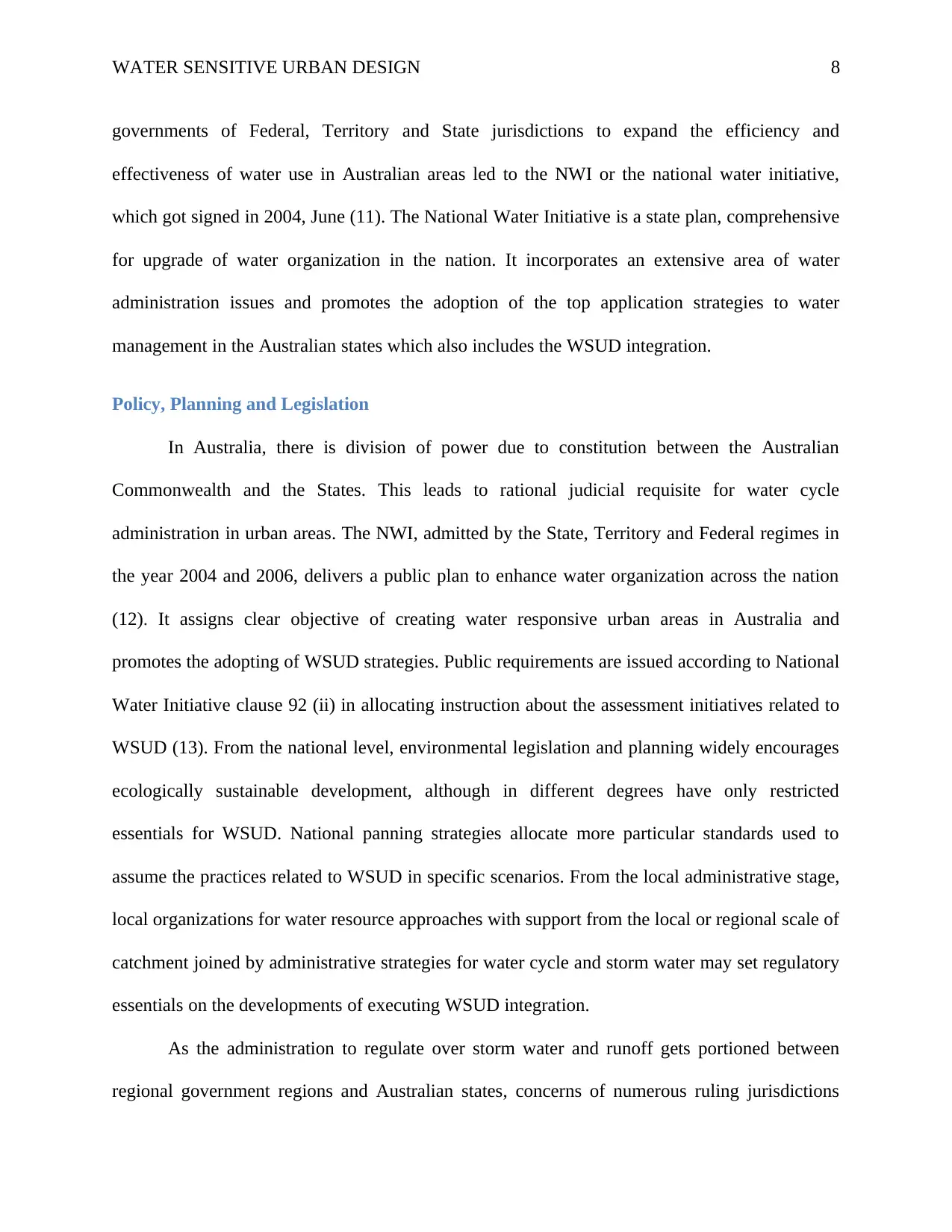
WATER SENSITIVE URBAN DESIGN 8
governments of Federal, Territory and State jurisdictions to expand the efficiency and
effectiveness of water use in Australian areas led to the NWI or the national water initiative,
which got signed in 2004, June (11). The National Water Initiative is a state plan, comprehensive
for upgrade of water organization in the nation. It incorporates an extensive area of water
administration issues and promotes the adoption of the top application strategies to water
management in the Australian states which also includes the WSUD integration.
Policy, Planning and Legislation
In Australia, there is division of power due to constitution between the Australian
Commonwealth and the States. This leads to rational judicial requisite for water cycle
administration in urban areas. The NWI, admitted by the State, Territory and Federal regimes in
the year 2004 and 2006, delivers a public plan to enhance water organization across the nation
(12). It assigns clear objective of creating water responsive urban areas in Australia and
promotes the adopting of WSUD strategies. Public requirements are issued according to National
Water Initiative clause 92 (ii) in allocating instruction about the assessment initiatives related to
WSUD (13). From the national level, environmental legislation and planning widely encourages
ecologically sustainable development, although in different degrees have only restricted
essentials for WSUD. National panning strategies allocate more particular standards used to
assume the practices related to WSUD in specific scenarios. From the local administrative stage,
local organizations for water resource approaches with support from the local or regional scale of
catchment joined by administrative strategies for water cycle and storm water may set regulatory
essentials on the developments of executing WSUD integration.
As the administration to regulate over storm water and runoff gets portioned between
regional government regions and Australian states, concerns of numerous ruling jurisdictions
governments of Federal, Territory and State jurisdictions to expand the efficiency and
effectiveness of water use in Australian areas led to the NWI or the national water initiative,
which got signed in 2004, June (11). The National Water Initiative is a state plan, comprehensive
for upgrade of water organization in the nation. It incorporates an extensive area of water
administration issues and promotes the adoption of the top application strategies to water
management in the Australian states which also includes the WSUD integration.
Policy, Planning and Legislation
In Australia, there is division of power due to constitution between the Australian
Commonwealth and the States. This leads to rational judicial requisite for water cycle
administration in urban areas. The NWI, admitted by the State, Territory and Federal regimes in
the year 2004 and 2006, delivers a public plan to enhance water organization across the nation
(12). It assigns clear objective of creating water responsive urban areas in Australia and
promotes the adopting of WSUD strategies. Public requirements are issued according to National
Water Initiative clause 92 (ii) in allocating instruction about the assessment initiatives related to
WSUD (13). From the national level, environmental legislation and planning widely encourages
ecologically sustainable development, although in different degrees have only restricted
essentials for WSUD. National panning strategies allocate more particular standards used to
assume the practices related to WSUD in specific scenarios. From the local administrative stage,
local organizations for water resource approaches with support from the local or regional scale of
catchment joined by administrative strategies for water cycle and storm water may set regulatory
essentials on the developments of executing WSUD integration.
As the administration to regulate over storm water and runoff gets portioned between
regional government regions and Australian states, concerns of numerous ruling jurisdictions
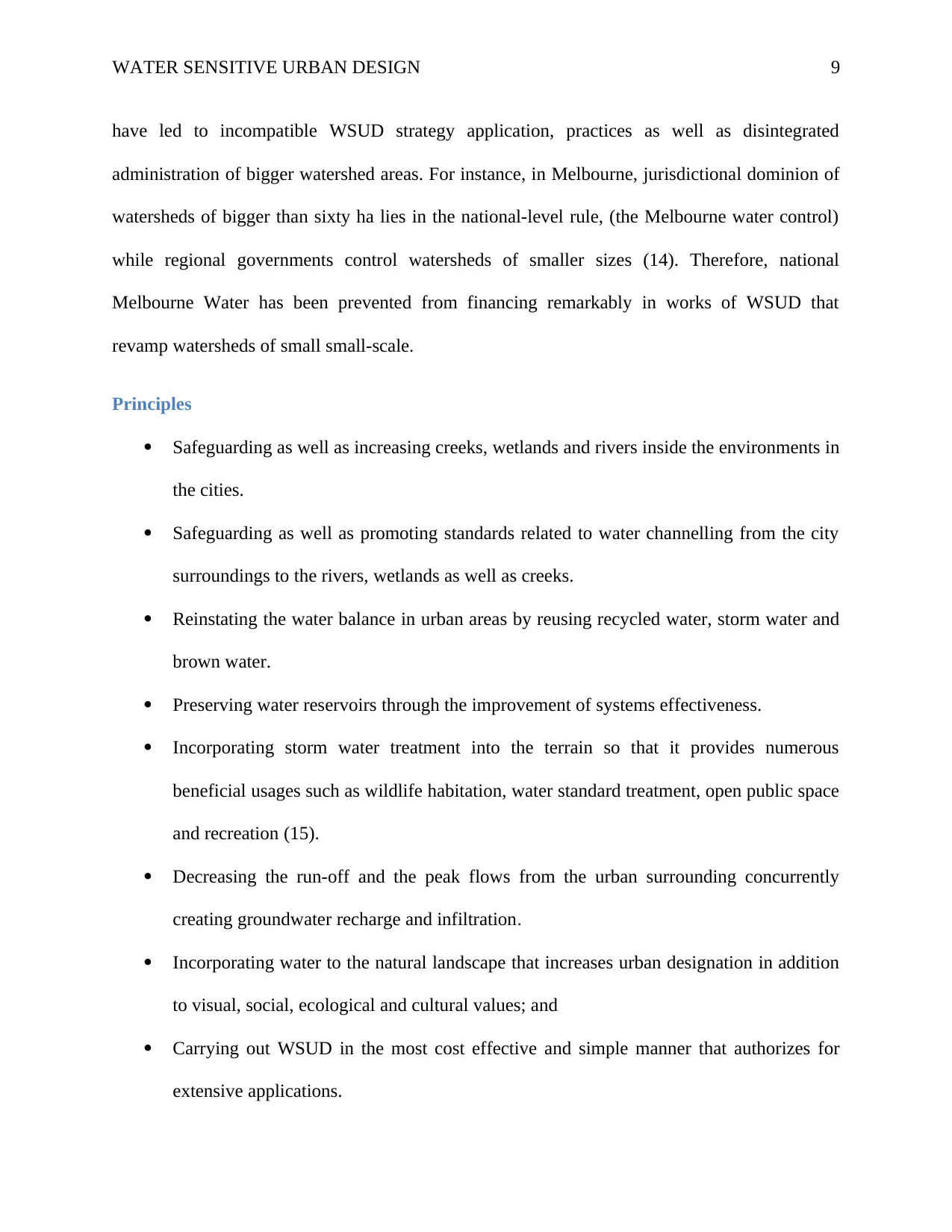
WATER SENSITIVE URBAN DESIGN 9
have led to incompatible WSUD strategy application, practices as well as disintegrated
administration of bigger watershed areas. For instance, in Melbourne, jurisdictional dominion of
watersheds of bigger than sixty ha lies in the national-level rule, (the Melbourne water control)
while regional governments control watersheds of smaller sizes (14). Therefore, national
Melbourne Water has been prevented from financing remarkably in works of WSUD that
revamp watersheds of small small-scale.
Principles
Safeguarding as well as increasing creeks, wetlands and rivers inside the environments in
the cities.
Safeguarding as well as promoting standards related to water channelling from the city
surroundings to the rivers, wetlands as well as creeks.
Reinstating the water balance in urban areas by reusing recycled water, storm water and
brown water.
Preserving water reservoirs through the improvement of systems effectiveness.
Incorporating storm water treatment into the terrain so that it provides numerous
beneficial usages such as wildlife habitation, water standard treatment, open public space
and recreation (15).
Decreasing the run-off and the peak flows from the urban surrounding concurrently
creating groundwater recharge and infiltration.
Incorporating water to the natural landscape that increases urban designation in addition
to visual, social, ecological and cultural values; and
Carrying out WSUD in the most cost effective and simple manner that authorizes for
extensive applications.
have led to incompatible WSUD strategy application, practices as well as disintegrated
administration of bigger watershed areas. For instance, in Melbourne, jurisdictional dominion of
watersheds of bigger than sixty ha lies in the national-level rule, (the Melbourne water control)
while regional governments control watersheds of smaller sizes (14). Therefore, national
Melbourne Water has been prevented from financing remarkably in works of WSUD that
revamp watersheds of small small-scale.
Principles
Safeguarding as well as increasing creeks, wetlands and rivers inside the environments in
the cities.
Safeguarding as well as promoting standards related to water channelling from the city
surroundings to the rivers, wetlands as well as creeks.
Reinstating the water balance in urban areas by reusing recycled water, storm water and
brown water.
Preserving water reservoirs through the improvement of systems effectiveness.
Incorporating storm water treatment into the terrain so that it provides numerous
beneficial usages such as wildlife habitation, water standard treatment, open public space
and recreation (15).
Decreasing the run-off and the peak flows from the urban surrounding concurrently
creating groundwater recharge and infiltration.
Incorporating water to the natural landscape that increases urban designation in addition
to visual, social, ecological and cultural values; and
Carrying out WSUD in the most cost effective and simple manner that authorizes for
extensive applications.
⊘ This is a preview!⊘
Do you want full access?
Subscribe today to unlock all pages.

Trusted by 1+ million students worldwide
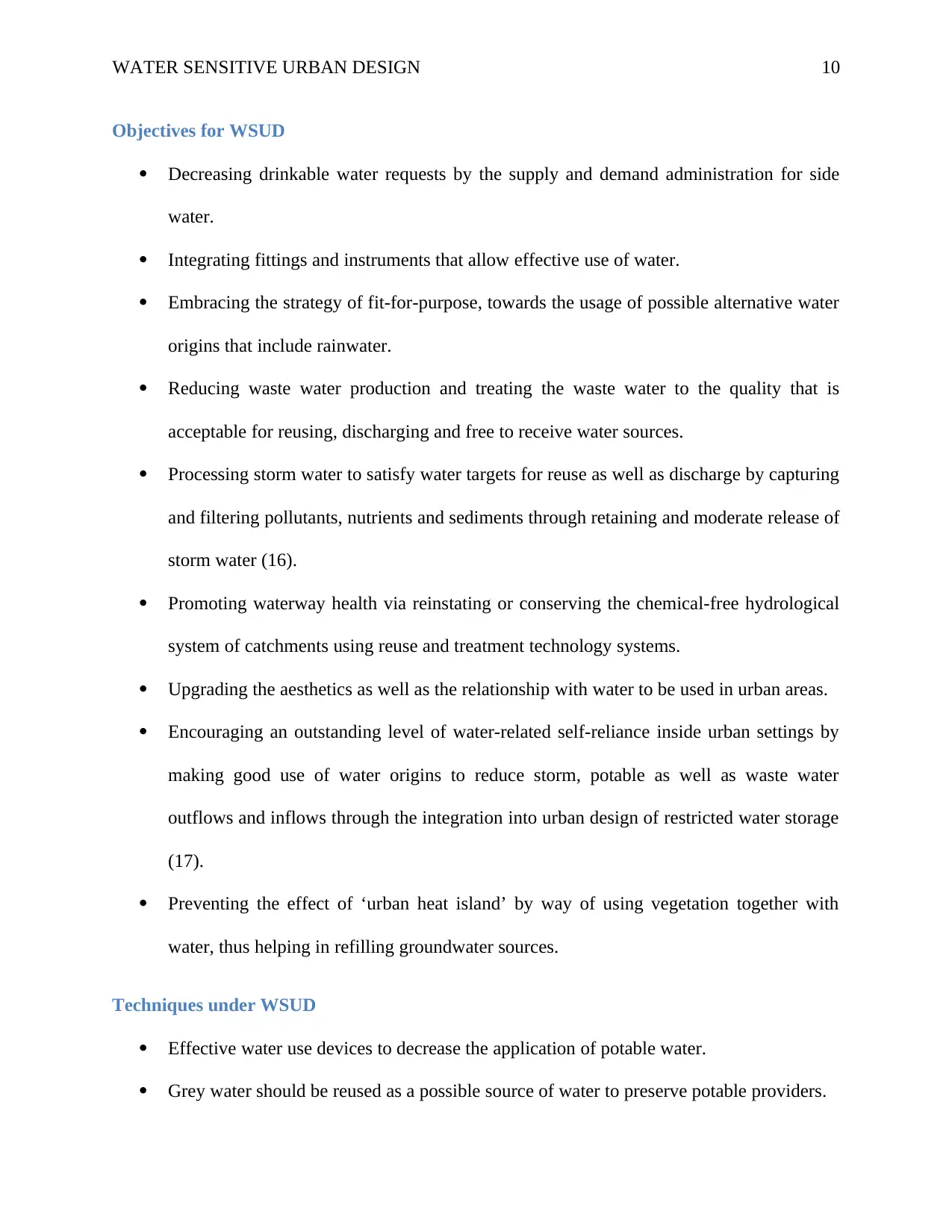
WATER SENSITIVE URBAN DESIGN 10
Objectives for WSUD
Decreasing drinkable water requests by the supply and demand administration for side
water.
Integrating fittings and instruments that allow effective use of water.
Embracing the strategy of fit-for-purpose, towards the usage of possible alternative water
origins that include rainwater.
Reducing waste water production and treating the waste water to the quality that is
acceptable for reusing, discharging and free to receive water sources.
Processing storm water to satisfy water targets for reuse as well as discharge by capturing
and filtering pollutants, nutrients and sediments through retaining and moderate release of
storm water (16).
Promoting waterway health via reinstating or conserving the chemical-free hydrological
system of catchments using reuse and treatment technology systems.
Upgrading the aesthetics as well as the relationship with water to be used in urban areas.
Encouraging an outstanding level of water-related self-reliance inside urban settings by
making good use of water origins to reduce storm, potable as well as waste water
outflows and inflows through the integration into urban design of restricted water storage
(17).
Preventing the effect of ‘urban heat island’ by way of using vegetation together with
water, thus helping in refilling groundwater sources.
Techniques under WSUD
Effective water use devices to decrease the application of potable water.
Grey water should be reused as a possible source of water to preserve potable providers.
Objectives for WSUD
Decreasing drinkable water requests by the supply and demand administration for side
water.
Integrating fittings and instruments that allow effective use of water.
Embracing the strategy of fit-for-purpose, towards the usage of possible alternative water
origins that include rainwater.
Reducing waste water production and treating the waste water to the quality that is
acceptable for reusing, discharging and free to receive water sources.
Processing storm water to satisfy water targets for reuse as well as discharge by capturing
and filtering pollutants, nutrients and sediments through retaining and moderate release of
storm water (16).
Promoting waterway health via reinstating or conserving the chemical-free hydrological
system of catchments using reuse and treatment technology systems.
Upgrading the aesthetics as well as the relationship with water to be used in urban areas.
Encouraging an outstanding level of water-related self-reliance inside urban settings by
making good use of water origins to reduce storm, potable as well as waste water
outflows and inflows through the integration into urban design of restricted water storage
(17).
Preventing the effect of ‘urban heat island’ by way of using vegetation together with
water, thus helping in refilling groundwater sources.
Techniques under WSUD
Effective water use devices to decrease the application of potable water.
Grey water should be reused as a possible source of water to preserve potable providers.
Paraphrase This Document
Need a fresh take? Get an instant paraphrase of this document with our AI Paraphraser
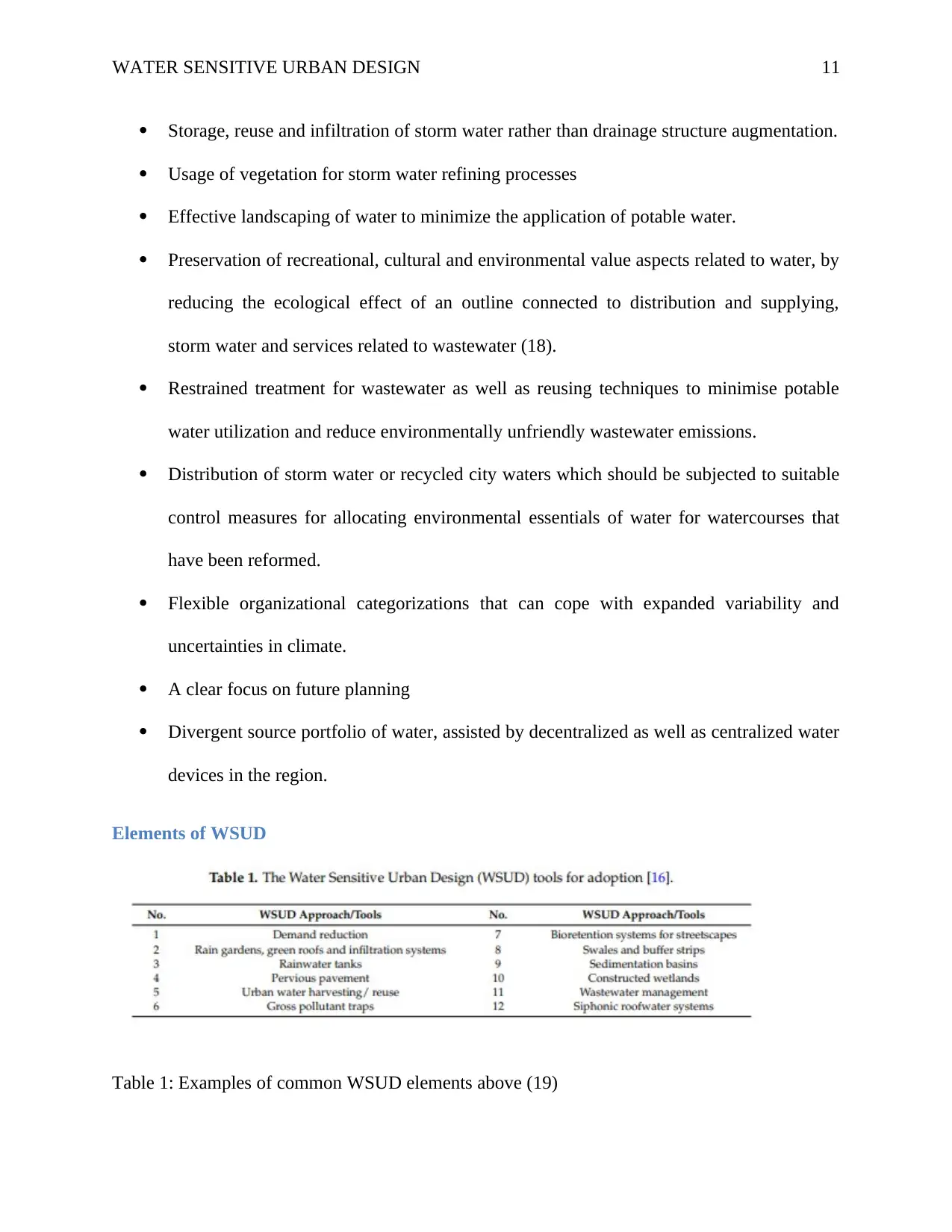
WATER SENSITIVE URBAN DESIGN 11
Storage, reuse and infiltration of storm water rather than drainage structure augmentation.
Usage of vegetation for storm water refining processes
Effective landscaping of water to minimize the application of potable water.
Preservation of recreational, cultural and environmental value aspects related to water, by
reducing the ecological effect of an outline connected to distribution and supplying,
storm water and services related to wastewater (18).
Restrained treatment for wastewater as well as reusing techniques to minimise potable
water utilization and reduce environmentally unfriendly wastewater emissions.
Distribution of storm water or recycled city waters which should be subjected to suitable
control measures for allocating environmental essentials of water for watercourses that
have been reformed.
Flexible organizational categorizations that can cope with expanded variability and
uncertainties in climate.
A clear focus on future planning
Divergent source portfolio of water, assisted by decentralized as well as centralized water
devices in the region.
Elements of WSUD
Table 1: Examples of common WSUD elements above (19)
Storage, reuse and infiltration of storm water rather than drainage structure augmentation.
Usage of vegetation for storm water refining processes
Effective landscaping of water to minimize the application of potable water.
Preservation of recreational, cultural and environmental value aspects related to water, by
reducing the ecological effect of an outline connected to distribution and supplying,
storm water and services related to wastewater (18).
Restrained treatment for wastewater as well as reusing techniques to minimise potable
water utilization and reduce environmentally unfriendly wastewater emissions.
Distribution of storm water or recycled city waters which should be subjected to suitable
control measures for allocating environmental essentials of water for watercourses that
have been reformed.
Flexible organizational categorizations that can cope with expanded variability and
uncertainties in climate.
A clear focus on future planning
Divergent source portfolio of water, assisted by decentralized as well as centralized water
devices in the region.
Elements of WSUD
Table 1: Examples of common WSUD elements above (19)
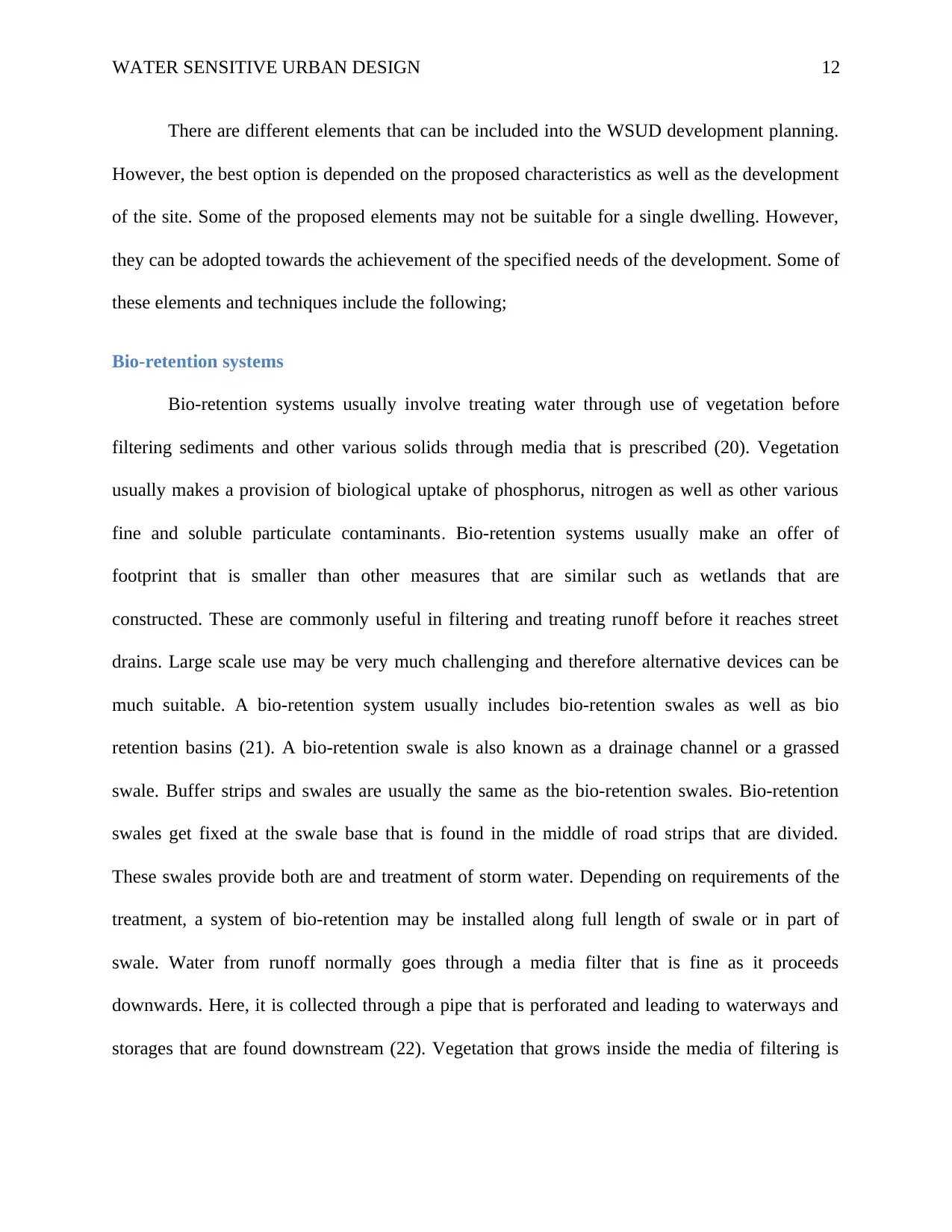
WATER SENSITIVE URBAN DESIGN 12
There are different elements that can be included into the WSUD development planning.
However, the best option is depended on the proposed characteristics as well as the development
of the site. Some of the proposed elements may not be suitable for a single dwelling. However,
they can be adopted towards the achievement of the specified needs of the development. Some of
these elements and techniques include the following;
Bio-retention systems
Bio-retention systems usually involve treating water through use of vegetation before
filtering sediments and other various solids through media that is prescribed (20). Vegetation
usually makes a provision of biological uptake of phosphorus, nitrogen as well as other various
fine and soluble particulate contaminants. Bio-retention systems usually make an offer of
footprint that is smaller than other measures that are similar such as wetlands that are
constructed. These are commonly useful in filtering and treating runoff before it reaches street
drains. Large scale use may be very much challenging and therefore alternative devices can be
much suitable. A bio-retention system usually includes bio-retention swales as well as bio
retention basins (21). A bio-retention swale is also known as a drainage channel or a grassed
swale. Buffer strips and swales are usually the same as the bio-retention swales. Bio-retention
swales get fixed at the swale base that is found in the middle of road strips that are divided.
These swales provide both are and treatment of storm water. Depending on requirements of the
treatment, a system of bio-retention may be installed along full length of swale or in part of
swale. Water from runoff normally goes through a media filter that is fine as it proceeds
downwards. Here, it is collected through a pipe that is perforated and leading to waterways and
storages that are found downstream (22). Vegetation that grows inside the media of filtering is
There are different elements that can be included into the WSUD development planning.
However, the best option is depended on the proposed characteristics as well as the development
of the site. Some of the proposed elements may not be suitable for a single dwelling. However,
they can be adopted towards the achievement of the specified needs of the development. Some of
these elements and techniques include the following;
Bio-retention systems
Bio-retention systems usually involve treating water through use of vegetation before
filtering sediments and other various solids through media that is prescribed (20). Vegetation
usually makes a provision of biological uptake of phosphorus, nitrogen as well as other various
fine and soluble particulate contaminants. Bio-retention systems usually make an offer of
footprint that is smaller than other measures that are similar such as wetlands that are
constructed. These are commonly useful in filtering and treating runoff before it reaches street
drains. Large scale use may be very much challenging and therefore alternative devices can be
much suitable. A bio-retention system usually includes bio-retention swales as well as bio
retention basins (21). A bio-retention swale is also known as a drainage channel or a grassed
swale. Buffer strips and swales are usually the same as the bio-retention swales. Bio-retention
swales get fixed at the swale base that is found in the middle of road strips that are divided.
These swales provide both are and treatment of storm water. Depending on requirements of the
treatment, a system of bio-retention may be installed along full length of swale or in part of
swale. Water from runoff normally goes through a media filter that is fine as it proceeds
downwards. Here, it is collected through a pipe that is perforated and leading to waterways and
storages that are found downstream (22). Vegetation that grows inside the media of filtering is
⊘ This is a preview!⊘
Do you want full access?
Subscribe today to unlock all pages.

Trusted by 1+ million students worldwide
1 out of 28
Related Documents
Your All-in-One AI-Powered Toolkit for Academic Success.
+13062052269
info@desklib.com
Available 24*7 on WhatsApp / Email
![[object Object]](/_next/static/media/star-bottom.7253800d.svg)
Unlock your academic potential
Copyright © 2020–2025 A2Z Services. All Rights Reserved. Developed and managed by ZUCOL.





